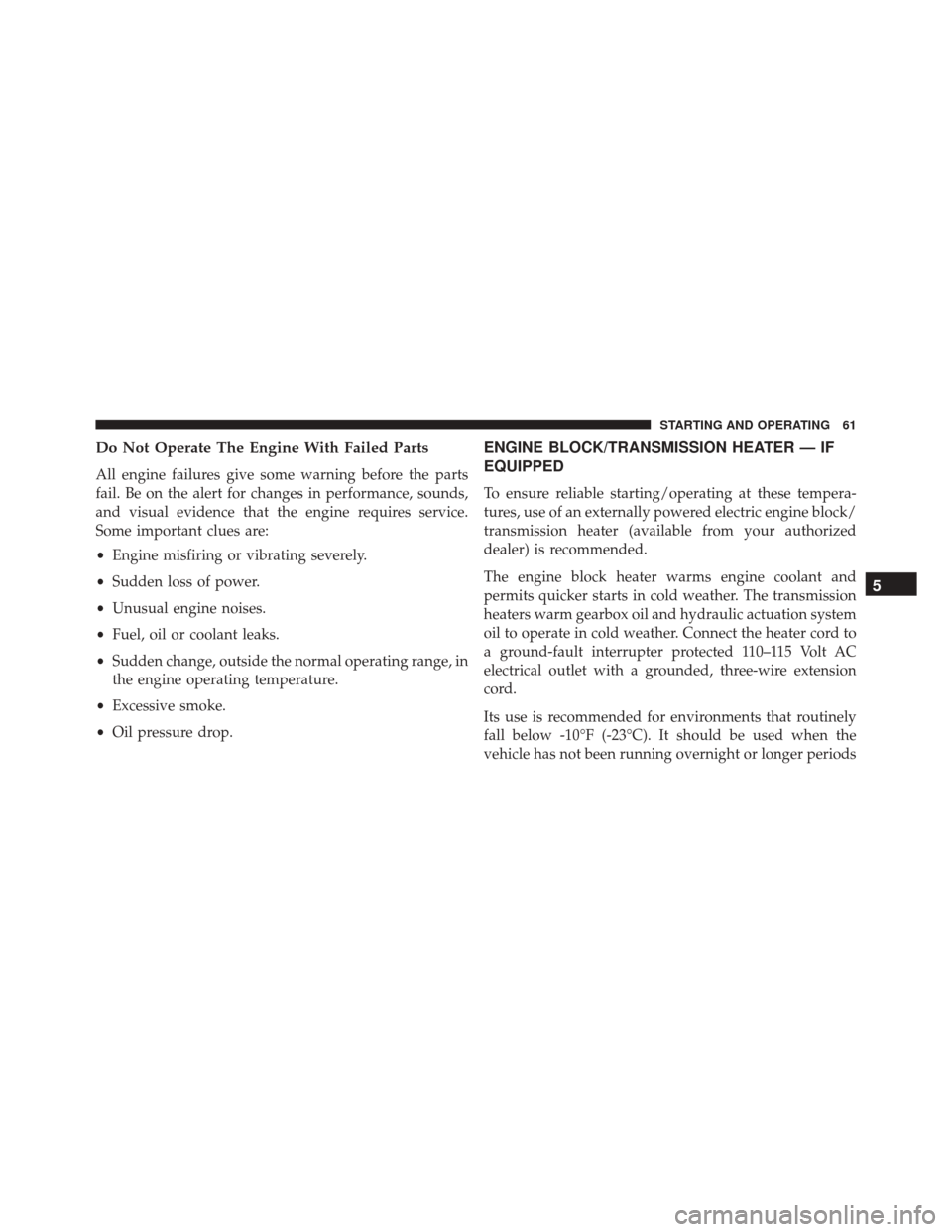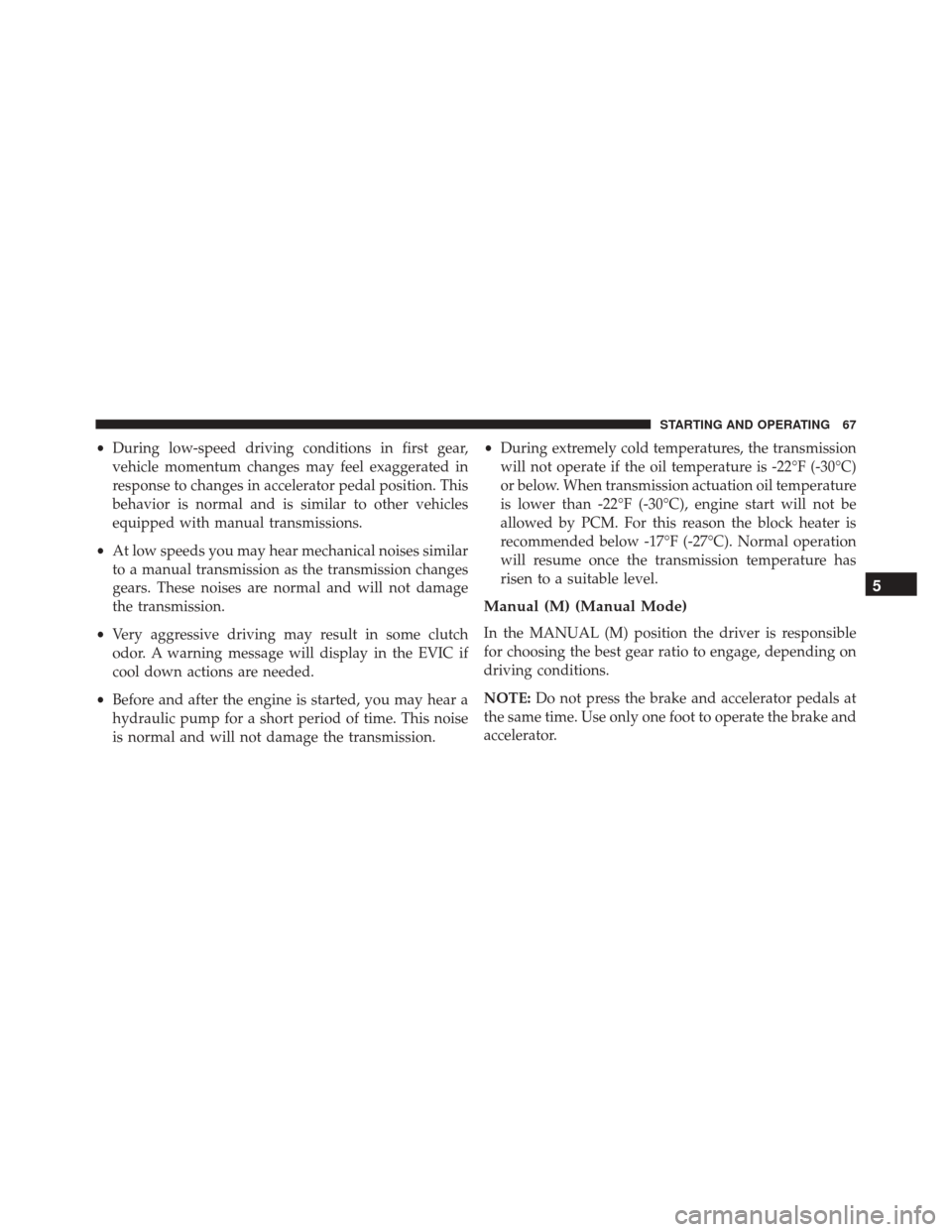Page 10 of 145

ENGINE BREAK-IN RECOMMENDATIONS
The diesel engine does not require a break-in period due
to its construction. Normal operation is allowed, provid-
ing the following recommendations are followed:
•Warm up the engine before placing it under load.
• Do not operate the engine at idle for prolonged
periods.
• Use the appropriate transmission gear to prevent
engine lugging.
• Observe vehicle oil pressure and temperature indica-
tors.
• Check the coolant and oil levels frequently.
• Vary accelerator pedal position at highway speeds
when carrying or towing significant weight. NOTE:
Light duty operation such as light trailer towing
or no load operation will extend the time before the
engine is at full efficiency. Reduced fuel economy and
power may be seen at this time.
The engine oil installed in the engine at the factory is a
high-quality energy conserving type lubricant. Oil
changes should be consistent with anticipated climate
conditions under which vehicle operations will occur.
The recommended viscosity and quality grades are
shown under “Fluids, Lubricants and Genuine Parts”,
under “Maintaining Your Vehicle” in this manual. NON-
DETERGENT OR STRAIGHT MINERAL OILS MUST
NEVER BE USED.
8 THINGS TO KNOW BEFORE STARTING YOUR VEHICLE
Page 43 of 145
Generic Warning Indicator Light
Yellow TelltaleLight What It Means
Generic Warning Indicator Light
The Generic Warning Light will illuminate if any of the following conditions occur: Oil
Change Request, Engine Oil Pressure Sensor Failure, External Light Failure, Fuel Cut-Off
Not Available, Parking Sensor Failure, DST System Failure.
4
UNDERSTANDING YOUR INSTRUMENT PANEL 41
Page 63 of 145

Do Not Operate The Engine With Failed Parts
All engine failures give some warning before the parts
fail. Be on the alert for changes in performance, sounds,
and visual evidence that the engine requires service.
Some important clues are:
•Engine misfiring or vibrating severely.
• Sudden loss of power.
• Unusual engine noises.
• Fuel, oil or coolant leaks.
• Sudden change, outside the normal operating range, in
the engine operating temperature.
• Excessive smoke.
• Oil pressure drop.
ENGINE BLOCK/TRANSMISSION HEATER — IF
EQUIPPED
To ensure reliable starting/operating at these tempera-
tures, use of an externally powered electric engine block/
transmission heater (available from your authorized
dealer) is recommended.
The engine block heater warms engine coolant and
permits quicker starts in cold weather. The transmission
heaters warm gearbox oil and hydraulic actuation system
oil to operate in cold weather. Connect the heater cord to
a ground-fault interrupter protected 110–115 Volt AC
electrical outlet with a grounded, three-wire extension
cord.
Its use is recommended for environments that routinely
fall below -10°F (-23°C). It should be used when the
vehicle has not been running overnight or longer periods
5
STARTING AND OPERATING 61
Page 69 of 145

•During low-speed driving conditions in first gear,
vehicle momentum changes may feel exaggerated in
response to changes in accelerator pedal position. This
behavior is normal and is similar to other vehicles
equipped with manual transmissions.
• At low speeds you may hear mechanical noises similar
to a manual transmission as the transmission changes
gears. These noises are normal and will not damage
the transmission.
• Very aggressive driving may result in some clutch
odor. A warning message will display in the EVIC if
cool down actions are needed.
• Before and after the engine is started, you may hear a
hydraulic pump for a short period of time. This noise
is normal and will not damage the transmission. •
During extremely cold temperatures, the transmission
will not operate if the oil temperature is -22°F (-30°C)
or below. When transmission actuation oil temperature
is lower than -22°F (-30°C), engine start will not be
allowed by PCM. For this reason the block heater is
recommended below -17°F (-27°C). Normal operation
will resume once the transmission temperature has
risen to a suitable level.
Manual (M) (Manual Mode)
In the MANUAL (M) position the driver is responsible
for choosing the best gear ratio to engage, depending on
driving conditions.
NOTE: Do not press the brake and accelerator pedals at
the same time. Use only one foot to operate the brake and
accelerator.
5
STARTING AND OPERATING 67
Page 81 of 145

Biodiesel Fuel Requirements
A maximum blend of 5% biodiesel meeting ASTM speci-
fication D975 is recommended for use with your diesel
engine. If frequent operation with Biodiesel blends that
are between 6% and 20% (B6–B20) is desired, the main-
tenance schedule is subject to shorter intervals.
The oil and filter change along with fuel filter replace-
ment is subject to shorter intervals when operating your
engine on biodiesel greater than 5%. Do not use biodiesel
greater than 20%.
For regular use of biodiesel blends between 6% and 20%
(B6–B20) it is important that you understand and comply
with these requirements. Refer to the “Maintenance
Chart” in the “Maintenance Schedules” section for fur-
ther direction.
CAUTION!
Failure to comply with Oil Change requirements for
vehicles operating on biodiesel blends between 6%
and 20% (B6–B20) will result in premature engine
wear. Such wear is not covered by the New Vehicle
Limited Warranty.
Biodiesel is a fuel produced from renewable resources
typically derived from animal fat, rapeseed oil (Rapeseed
Methyl Ester (RME) base), or soybean oil (Soy Methyl
Ester (SME or SOME) base).
Biodiesel fuel has inherent limitations which require that
you understand and adhere to the following requirements
if you use blends of Biodiesel between 6% and 20%
(B6–B20). There are no unique restrictions for the use of B5.
5
STARTING AND OPERATING 79
Page 83 of 145

Fuel Water Separation — Must Use Mopar
Approved Fuel Filter Elements
Biodiesel fuel has a natural affinity to water and water
accelerates microbial growth. Your Mopar filtration sys-
tem is designed to provide adequate fuel water separa-
tion capabilities.
Fuel In Oil Dilution — Must Adhere To Required
Oil Change
Fuel dilution of lubricating oil has been observed with
the use of biodiesel fuel. Fuel in oil must not exceed 5%.
To ensure this limit is met your oil change interval must
be maintained with in the suggested schedule.
The regular use of biofuels greater than 5% and less than
20% require intervals shorter than the outlined 18,500 miles
(29 773 km) and must not exceed the suggested schedule.
When routinely operating on biofuels greater that 5% and
less than 20%, oil and filter replacement intervals must not
exceed 10,000 miles (16 093 km) or 6 months, which ever
comes first.
Biodiesel Fuel Filter Change Intervals
The use of biofuels require intervals shorter than the
outlined 30,000 miles (48 280 km) and must not exceed
the suggested schedule. When operating on biofuels
greater that 5% and less than 20%, fuel filter replacement
intervals must not exceed 20,000 Miles (40 233 km).
NOTE:
•Under no circumstances should oil change intervals
exceed 10,000 miles (16 093 km) or 6 months, if regular
operation occurs with greater than 5% and less than
20% biodiesel blends.
•
Under no circumstances should fuel filter intervals
exceed 20,000 miles (40 233 km), if regular operation
occurs with greater than 5% and less than 20% biodiesel
blends.
5
STARTING AND OPERATING 81
Page 84 of 145
CAUTION!
Failure to comply with these Oil Change and fuel
filter requirements for vehicles operating on bio-
diesel blends up to B20 may result in premature
engine wear. Such wear is not covered by the New
Vehicle Limited Warranty. The engine may suffer
severe damage if operated with concentrations of
biodiesel higher than 20%.
ADDING FUEL
The fuel cap is located behind the fuel filler door on the
left side of the vehicle. If the fuel cap is lost or damaged,
be sure the replacement cap is for use with this vehicle.
CAUTION!
To avoid fuel spillage and overfilling, do not “top
off” the fuel tank after filling.
1 — Diesel Fuel Fill Location
2 — Diesel Exhaust Fluid (DEF) Fill Location
82 STARTING AND OPERATING
Page 107 of 145

only when the level on the dipstick is below the mini-
mum notch. The total capacity from the minimum notch
to the maximum notch is 1.7 quarts (1.6 liters).
CAUTION!
Overfilling or underfilling the crankcase will cause
oil aeration or loss of oil pressure. This could damage
your engine.
NOTE: It is possible for your oil level to be slightly
higher than a previous check. This would be due to diesel
fuel that may temporarily be in the crankcase due to
operation of the diesel particulate filter regeneration
strategy. This fuel will evaporate out under normal
operation.
Never operate the engine with oil level below the mini-
mum notch or above the upper maximum notch.
Change Engine Oil
Refer to the “Maintenance Schedule” for the proper
maintenance intervals.
Engine Oil Viscosity (SAE Grade)
CAUTION!
Your vehicle is equipped with an advanced technol-
ogy Diesel Engine and an emission device designed
to limit Diesel Particulate Emissions from being
released into the atmosphere. The durability of your
engine and life expectancy of this diesel particulate
filter emission device is highly dependent on the use
of the correct engine oil.
Only use ACEA C3 SAE 5W-30 Synthetic Low Ash engine
oil meeting FCA US Material Standard MS-11106 or
Pennzoil Ultra Euro L full synthetic 5W-30 motor oil,
6
MAINTAINING YOUR VEHICLE 105